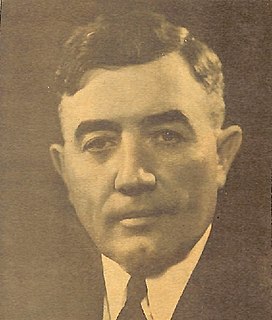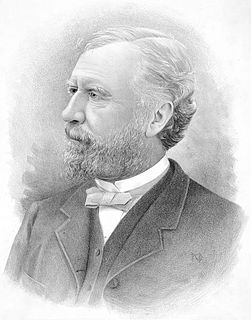
Thomas Andrews Hendricks was an American politician and lawyer from Indiana who served as the 16th governor of Indiana from 1873 to 1877 and the 21st vice president of the United States from March to November 1885. Hendricks represented Indiana in the U.S. House of Representatives (1851–1855) and the U.S. Senate (1863–1869). He also represented Shelby County, Indiana, in the Indiana General Assembly (1848–1850) and as a delegate to the 1851 Indiana constitutional convention. In addition, Hendricks served as commissioner of the General Land Office (1855–1859). Hendricks, a popular member of the Democratic Party, was a fiscal conservative. He defended the Democratic position in the U.S. Senate during the American Civil War and Reconstruction era and voted against the Thirteenth, Fourteenth, and Fifteenth Amendments to the U.S. Constitution. He also opposed Radical Reconstruction and President Andrew Johnson's removal from office following Johnson's impeachment in the U.S. House.

The governor of Indiana is the head of government of the State of Indiana. The governor is elected to a four-year term and is responsible for overseeing the day-to-day management of the functions of many agencies of the Indiana state government. The governor also shares power with other statewide executive officers, who manage other state government agencies. The governor works out of the Indiana Statehouse and holds official functions at the Indiana Governor's Residence in the state capital of Indianapolis.

The Indiana General Assembly is the state legislature, or legislative branch, of the state of Indiana. It is a bicameral legislature that consists of a lower house, the Indiana House of Representatives, and an upper house, the Indiana Senate. The General Assembly meets annually at the Indiana Statehouse in Indianapolis.

James Brown Ray was an Indiana politician and the only Indiana Senate president pro tempore to be elevated to governor of the state of Indiana. Ray served during a time when the state transitioned from personal politics to political parties, but never joined a party himself. Taking office one week before his 31st birthday, he became the state's youngest governor and served from 1825 to 1831, the longest period for an Indiana governor under the state constitution of 1816. During Ray's term as governor the state experienced a period of economic prosperity and a 45 percent population increase. He supported projects that encouraged the continued growth and development of the young state, most notably internal improvements, Native American removal, codification of Indiana's laws, improved county and local government, and expanded educational opportunities. Ray was known for his eccentricity and early promotion of a large-scale railroad system in the state. His support for new railroad construction and alleged involvement in several scandals caused him to lose popularity among voters. Ray's opponents who favored the creation of canals considered railroads to be an impractical, utopian idea. Following Ray's departure from political office, he continued to advocate for a statewide railroad system until his death in 1848.

Oliver Hazard Perry Throck Morton, commonly known as Oliver P. Morton, was a U.S. Republican Party politician from Indiana. He served as the 14th governor of Indiana during the American Civil War, and was a stalwart ally of President Abraham Lincoln. During the war, Morton thwarted and neutralized the Democratic-controlled Indiana General Assembly. He exceeded his constitutional authority by calling out the militia without approval, and during the period of legislative suppression he privately financed the state government through unapproved federal and private loans. He was criticized for arresting and detaining political enemies and suspected southern sympathizers. As one of President Lincoln's "war governors", Morton made significant contributions to the war effort, more than any other man in the state, and earned the lifelong gratitude of former Union soldiers for his support.

Edgar Doud Whitcomb was an American attorney, writer and politician, who served as the 43rd governor of Indiana. His term as governor began a major rift in the Indiana Republican Party as urban Republicans became more numerous than rural Republicans, leading to a shift in the priorities of the party leadership.

Alvin Peterson Hovey was a Union general during the American Civil War, an Indiana Supreme Court justice, congressman, and the 21st governor of Indiana from 1889 to 1891. During the war he played an important role in the Western theatre, earning high approval from General Ulysses Grant, and uncovered a secret plot for an uprising in Indiana. As governor, he launched several legal challenges to the Indiana General Assembly's removal of his powers, but was mostly unsuccessful. He successfully advocated election reform before he died in office.

James Putnam Goodrich,, was an American politician and member of the Republican Party who served as the 29th governor of Indiana from 1917 to 1921. His term focused on reforming the operations of the state government and overseeing the state's contributions for World War I. He nearly died twice during his term, and spent a considerable time bedridden. Following his term as governor, he became increasingly wealthy from his business interests and owned a controlling share in many companies.

Roger Douglas Branigin was an American politician who was the 42nd governor of Indiana, serving from January 11, 1965, to January 13, 1969. A World War II veteran and well-known public speaker, Branigin took office with a Democratic general assembly, the first time since the Great Depression that Democrats controlled both the executive and legislative branches of the Indiana state government. Branigin was a conservative Democrat who oversaw repeal of the state's personal property taxes on household goods, increased access to higher education, and began construction of Indiana's deep-water port at Burns Harbor on Lake Michigan. During his one term as governor, Branigin exercised his veto power one hundred times, a record number for a single term. Branigin was the last Democrat to serve as governor of Indiana until Evan Bayh took office in 1989.

Abram Adams Hammond was the 12th governor of the U.S. state of Indiana. He succeeded to the office upon the death of Governor Ashbel P. Willard and completed the remaining three months of Willard's term.

Conrad Baker was an American attorney, military officer, and politician that served as state representative, 15th lieutenant governor, and the 15th governor of the U.S. state of Indiana from 1867 to 1873. Baker had served in the Union Army during the American Civil War, rising to the rank of colonel but resigned following his election as lieutenant governor, during which time he played an important role in overseeing the formation and training of states levies. He served as acting-governor for five months during the illness of Governor Oliver Morton, and was elevated to Governor following Morton's resignation from office. During Baker's full term as governor, he focused primitively on the creation and improvement of institutions to help veterans and their families that had been disaffected by the war. He also championed the post-war federal constitutional amendments, and was able to successfully advocate their acceptance.

Maurice Clifford Townsend was an American politician and the 35th governor of the U.S. state of Indiana from 1937 to 1941. During his term, he led relief efforts during and after the Great Flood of 1937.

Henry Frederick Schricker was an American politician who served as the 36th and 38th Governor of the U.S. state of Indiana from 1941 to 1945 and from 1949 to 1953. He is the only Indiana governor elected to two non-consecutive terms, and the only governor between 1852 and 1977 to be elected to more than one term in office. His terms were marked by strong opposition party control of the Indiana General Assembly, which attempted to remove powers from the governor that had been granted during the Great Depression. Schricker fought the attempt in the state courts, and although his power was significantly reduced, the Indiana Supreme Court ruled in the case of Tucker v. Indiana that the governor was the chief executive of the state, and the legislature could not pass legislation that interfered with the division of powers.

Ralph Fesler Gates was an American politician who served as the 37th governor of the U.S. state of Indiana from 1945 to 1949. A lawyer and veteran of World War I, he is credited with returning his party to power after the Ku Klux Klan scandal in late 1920s that led to years of Democratic dominance of the state government during the Great Depression. His term in office focused primarily on encouraging economic growth as World War II ended through the improvement of the state highway system, education reform, and offering incentives for industrial growth. After leaving office he remained active as a leader in the state Republican Party until his death.

Harold Willis Handley was the 40th governor of the U.S. state of Indiana from 1957 to 1961. A veteran of World War II, and furniture salesman by trade, Handley began his political career as a state senator. Thanks to his longtime friendship with state party leader and United States Senator William E. Jenner, he was able to secure the nomination to run for lieutenant governor in 1952, during which time he opposed many of the actions of Governor George N. Craig. His popularity rose among the conservative leadership of the Indiana Republican Party and aided him in winning the nomination and subsequent election as governor in 1956.

Albert Gallatin Porter was an American politician who served as the 19th governor of Indiana from 1881 to 1885 and as a United States Congressman from 1859 to 1863. Originally a Democrat, he joined the Republican Party in 1856 after being expelled by the pro-slavery faction of the Democratic Party. Only the second person born in Indiana to become the state's governor, he reluctantly accepted his party's nomination to run. His term saw the start of Indiana's industrialization that continued for several decades. During the second half of his term a strong Democratic majority took control of the Indiana General Assembly and revoked all of the governor's appointment powers and other authorities, weakening the governors position to its lowest state in the history of the state.

The lieutenant governor of Indiana is a constitutional office in the US State of Indiana. Republican Suzanne Crouch, who assumed office January 9, 2017, is the incumbent. The office holder's constitutional roles are to serve as the president of the Indiana Senate, become acting governor during the incapacity of the governor, and become governor should the incumbent governor resign, die in office, or be impeached and removed from office. Lieutenant governors have succeeded ten governors following their deaths or resignations. The lieutenant governor holds statutory positions, serving as the head of the state agricultural and rural affairs bureaus, and as the chairman of several state committees. The annual salary of the lieutenant governor is $88,000.

The 1904 Indiana gubernatorial election was held on November 8, 1904 in all 92 counties in the state of Indiana. Frank Hanly was elected governor over his Democratic opponent, John W. Kern.




















